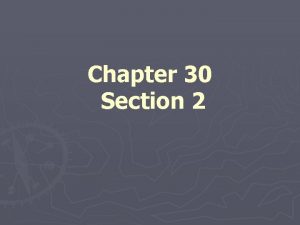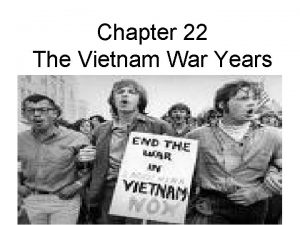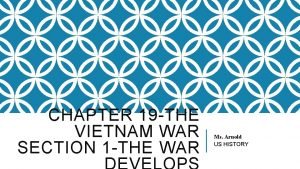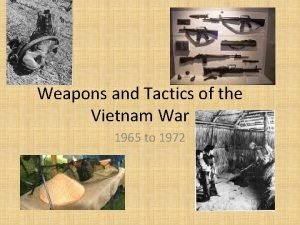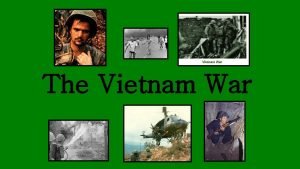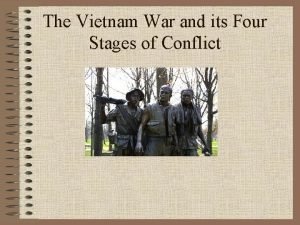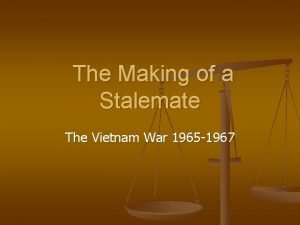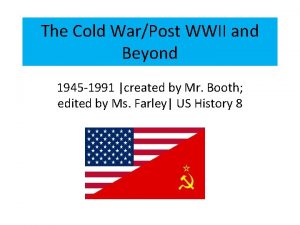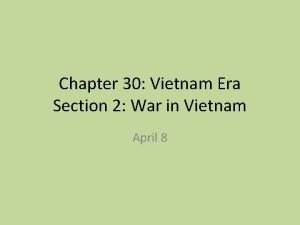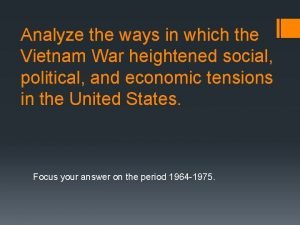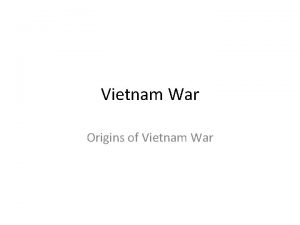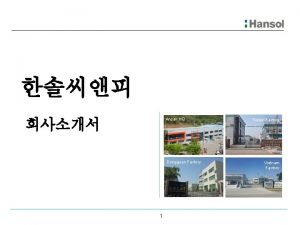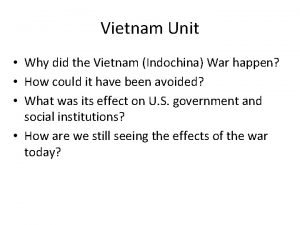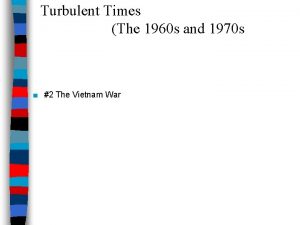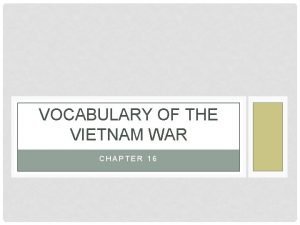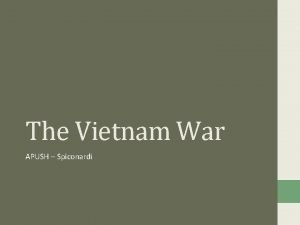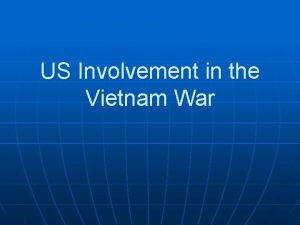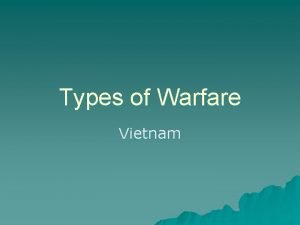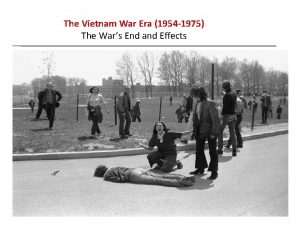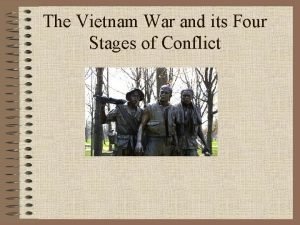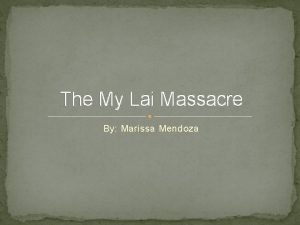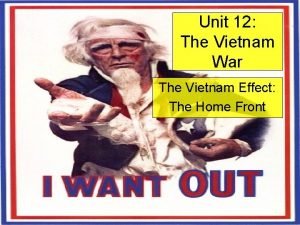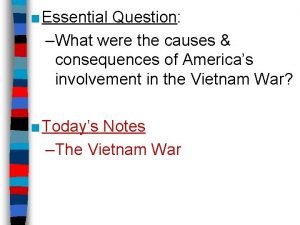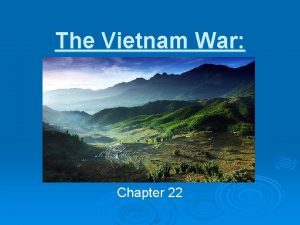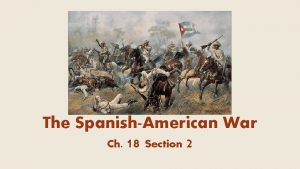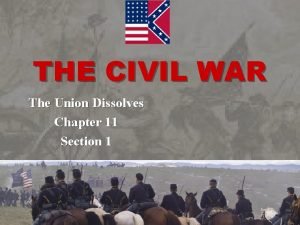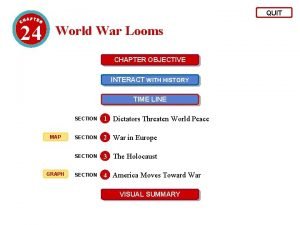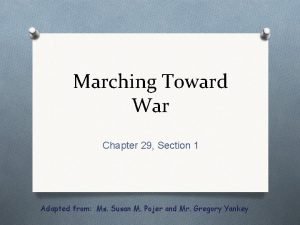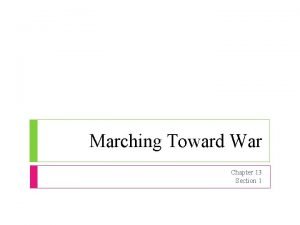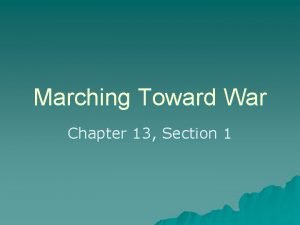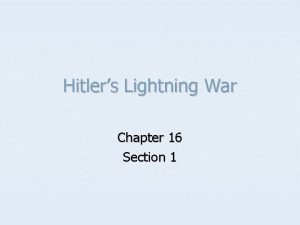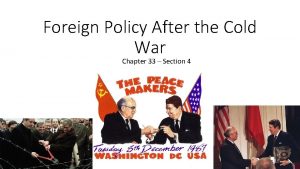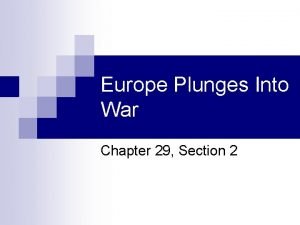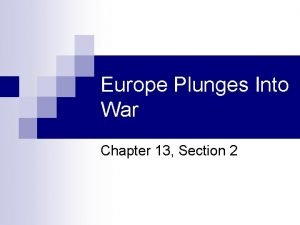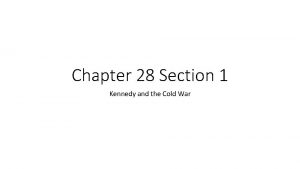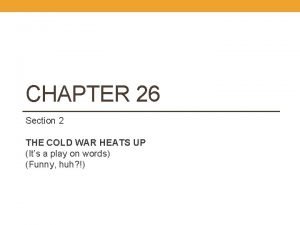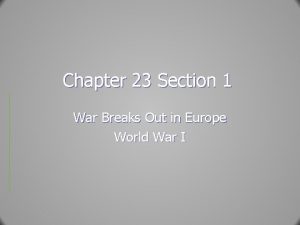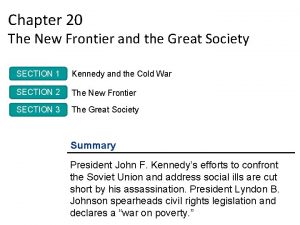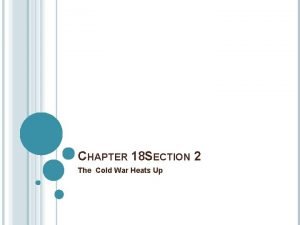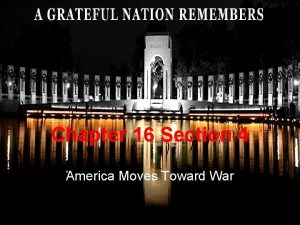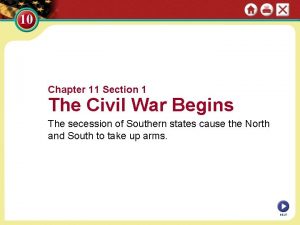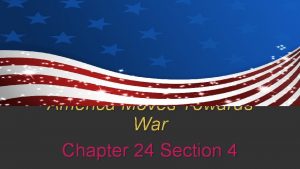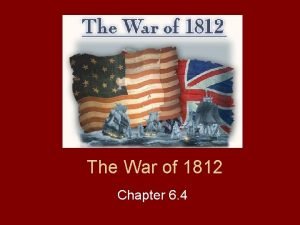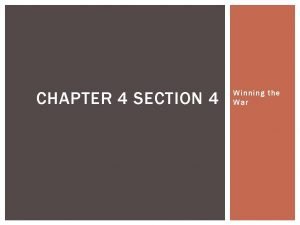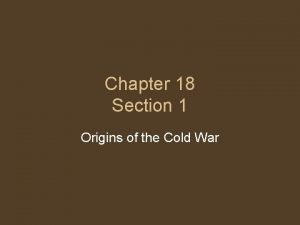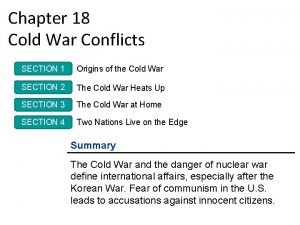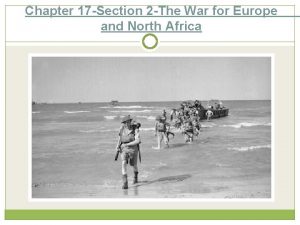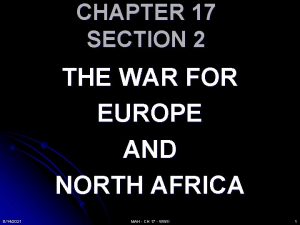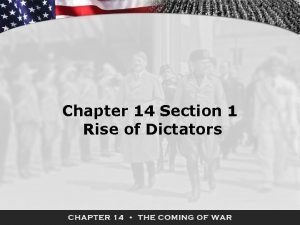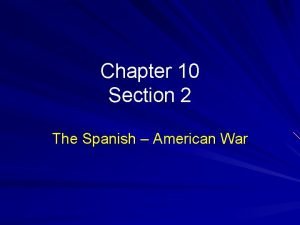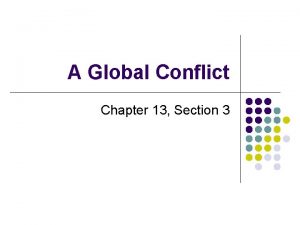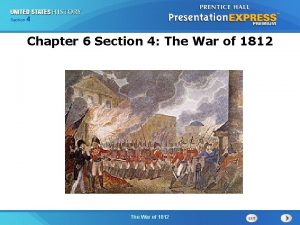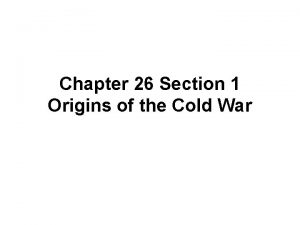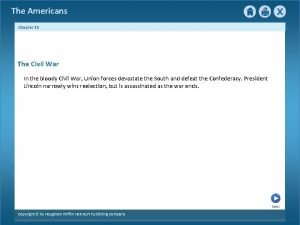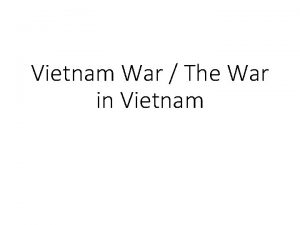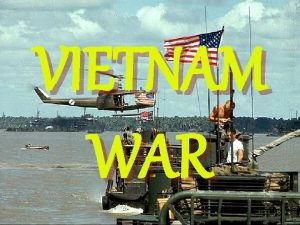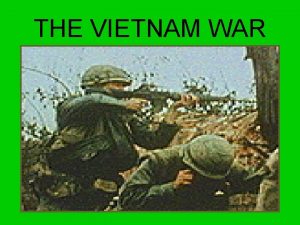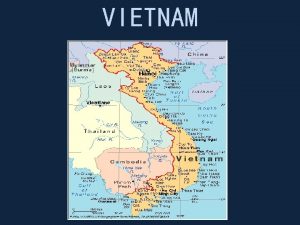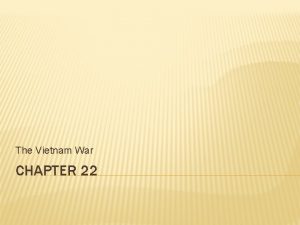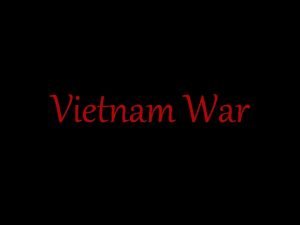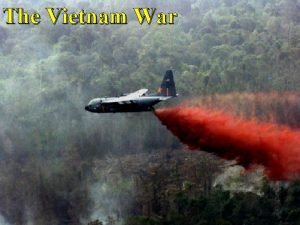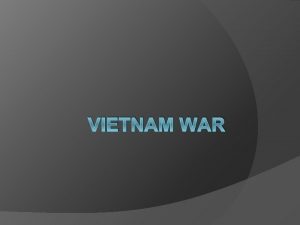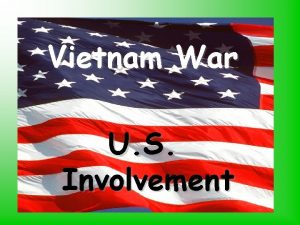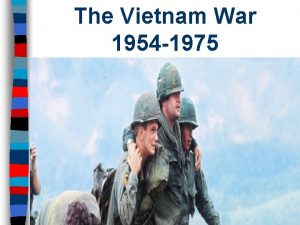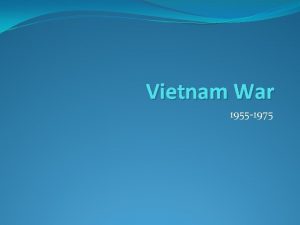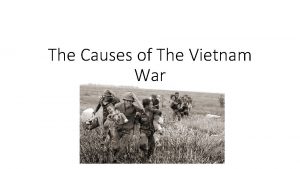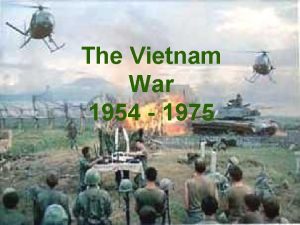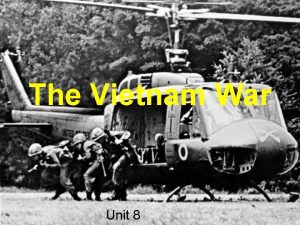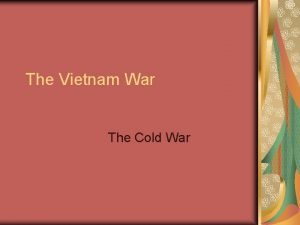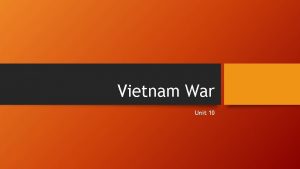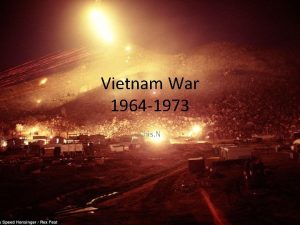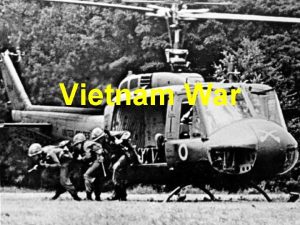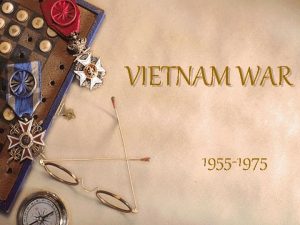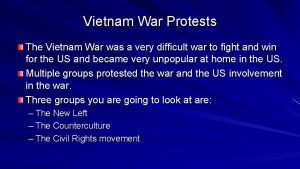CHAPTER 19 THE VIETNAM WAR SECTION 1 THE































































- Slides: 63

CHAPTER 19 -THE VIETNAM WAR SECTION 1 -THE WAR Ms. Arnold US HISTORY

CONCERN ABOUT THE SPREAD OF COMMUNISM LED THE UNITED STATES TO BECOME INCREASINGLY VIOLENT IN VIETNAM.

SOUTHEAST ASIA’S • COLONIAL France gained control of. HISTORY Vietnam by 1883 despite fierce resistance from the Vietnamese. • The French combined Vietnam with Laos and Cambodia to form French Indochina. • Ho Chi Minh led a growing nationalist movement in Vietnam. • During World War II, the Japanese army occupied French Indochina. • A group called the League for the Independence of Vietnam, or the Vietminh, fought the Japanese. • After World War II, the Vietminh declared independence, but the French quickly moved in to reclaim Vietnam.

QUESTION What country controlled Vietnam during World War II? a. the United States b. France c. China d. Japan

ANSWER What country controlled Vietnam during World War II? a. the United States b. France c. China d. Japan

WHAT POLICIES DID PRESIDENTS TRUMAN AND EISENHOWER PURSUE IN • Saw Vietnam AFTER in terms of the. WW Cold War struggle against VIETNAM II ? communism Truman • Supported France; unwilling to back the Vietminh because many were Communists Events • Communists seized China in 1949. • Communist North Korea invaded South Korea in 1950. Eisenhower • Communist-led revolts in Indonesia, Malaya, and the Philippines • Believed in the domino theory • Sent arms, ammunition, supplies, and money to the French forces in Vietnam.

DOMINO THEORY

QUESTION What is the domino theory? a. the strategy of dropping strings of bombs to destroy large areas b. the belief that if one country entered a war, neighboring countries would quickly follow c. the belief that if one country fell to communism, neighboring countries would quickly follow

ANSWER What is the domino theory? a. the strategy of dropping strings of bombs to destroy large areas b. the belief that if one country entered a war, neighboring countries would quickly follow c. the belief that if one country fell to communism, neighboring countries would quickly follow

VIETNAM AFTER WORLD WAR II • The Domino Theory France Defeated • Domino theory—the belief that communism would spread to neighboring countries if Vietnam fell to communism • To avoid this, the United States supported the French during the Vietnam War. • By 1954 the United States was paying more than 75 percent of the cost of the war. • The French continued to lose battle after battle. • French soldiers made a last stand at Dien Bien Phu. • French forces hoped for a U. S. rescue, but Eisenhower did not want to send U. S. soldiers to Asia so soon after Korea. • The French surrendered on May 7, 1954. • After eight years of fighting, the two sides had lost nearly 300, 000 soldiers. • The Vietminh had learned how to fight a guerilla war against an enemy with

THE GENEVA CONFERENCE • The goal of the Geneva Conference was to work out a peace agreement and arrange for Indochina’s future. • According to the Geneva Accords, Vietnam was temporarily divided at the 17 th parallel. • Vietminh forces controlled the North and the French would withdraw from the country. • General elections were to be held in July 1956 and would reunify the country under one government. • The United States never fully supported the peace agreements fearing that Ho Chi Minh and the Communists would win the nationwide election.

QUESTION What was the goal of the Geneva Conference? a. to decide which nations would control Vietnam in the future b. to determine the terms of the Vietnamese surrender to the French c. to work out a peace agreement and arrange for Indochina’s future d. to determine how and when elections would be held to select a new government for Vietnam

ANSWER What was the goal of the Geneva Conference? a. to decide which nations would control Vietnam in the future b. to determine the terms of the Vietnamese surrender to the French c. to work out a peace agreement and arrange for Indochina’s future d. to determine how and when elections would be held to select a new government for Vietnam

CONFLICT BETWEEN NORTH VIETNAM SOUTH VIETNAM • AND President Eisenhower hoped to prevent communism from spreading to South Vietnam. • South Vietnam’s leader was Ngo Dinh Diem. • North Vietnam’s leader was Ho Chi Mihn. • While Ho Chi Minh became more and more popular in North Vietnam, Ngo Dinh Diem’s corrupt and brutal leadership began to anger many South Vietnamese. • By the late 1950 s a civil war broke out in South Vietnam. • And by 1960, Ho Chi Minh expanded the effort to unify North and South Vietnam under a Communist government.

GROWING CONFLICT IN VIETNAM Vietnam’s Leaders A Civil War • Ngo Dinh Diem became the president of South Vietnam in 1954. • Diem’s government was corrupt, brutal, and unpopular from the start. • He favored Catholics and the wealthy. • Diem cancelled the 1956 election that would unify Vietnam under one government. • Ho Chi Minh’s leadership in North Vietnam was totalitarian and repressive. • Diem’s opponents in South Vietnam began to revolt. • North Vietnam supplied weapons to Vietminh rebels in South Vietnam. • The Vietminh in South Vietnam formed the National Liberation Front and called their military forces the Vietcong. • The Vietcong assassinated many South Vietnamese leaders and soon controlled much of the countryside. • In 1960 Ho Chi Minh sent the North Vietnamese Army into the country to fight with the Vietcong.

QUESTIONS How did Ho Chi Minh win support in North Vietnam despite his repressive regime? a. by instituting a representative democracy b. by killing all who opposed him c. by redistributing land from large estates to peasants d. by favoring Catholics

ANSWER How did Ho Chi Minh win support in North Vietnam despite his repressive regime? a. by instituting a representative democracy b. by killing all who opposed him c. by redistributing land from large estates to peasants d. by favoring Catholics

U. S. INVOLVEMENT IN VIETNAM • Began sending money and weapons to South Vietnam Eisenhower • Military advisors sent to train South Vietnamese army • Believed in the Domino Theory Kennedy • Increased the number of military advisors and army special forces, or Green Berets • Advisors were not to take part in combat, but many did Johnson • Believed an expanded U. S. effort was the only way to prevent a Communist victory in Vietnam • Asked Congress to pass the Tonkin Gulf Resolution

INCREASING U. S. INVOLVEMENT • Diem’s Overthrow • Tonkin Gulf Resolution • Diem’s government continued to grow more and more unpopular. • He arrested and killed Buddhist protesters. • U. S. leaders said they would withdraw support if Diem did not change his ways. • Diem refused to change his stand against Buddhists, and the United States began to support a plot to overthrow Diem. • In November 1963 the South • To increase the American military effort in Vietnam, Johnson needed to obtain authority from Congress. • Johnson asked Congress for this authority claiming that the USS Maddox had been attacked by North Vietnamese torpedo boats in the Gulf of Tonkin. • Johnson claimed this attack was unprovoked, but really the Maddox had been on a spying mission and had fired first. • The Tonkin Gulf Resolution was passed on August 7.

QUESTION Congress approved the Tonkin Gulf Resolution in 1964 because a. the U. S. ship Maddox had been the target of an unprovoked attack. b. Lyndon Johnson misled them. c. Congress members wanted to give the president the sole power to declare war. d. Congress members wanted to limit the president’s war-making powers.

ANSWER Congress approved the Tonkin Gulf Resolution in 1964 because a. the U. S. ship Maddox had been the target of an unprovoked attack. b. Lyndon Johnson misled them. c. Congress members wanted to give the president the sole power to declare war. d. Congress members wanted to limit the president’s war-making powers.

SECTION 2 -U. S. SUPPORT OF THE WAR AT HOME AND ABROAD Ms. Arnold US HISTORY

WHY DID U. S. SUPERIORITY IN THE AIR WAR FAIL TO WIN QUICKLY Weapons of the Air War IN VIETNAM? • Agent Orange—defoliant, The Air War Operation Rolling Thunder • A bombing campaign over North Vietnam • Bombed military targets —army bases and airfields—as well as bridges, roads, railways, and power plants • Main target was the Ho Chi Minh Trail or chemical, that destroys vegetation • Napalm—jellied form of gasoline used to create firebombs • “Cluster bombs”— sprayed sharp metal fragments when exploded • Bombing did not succeed • Flow of goods from North to South Vietnam actually increased • Vietcong repaired bridges, had bunkers underground, and used weapons from the Soviet Union and China

AGENT ORANGE

QUESTION What was Agent Orange?

Tunnels

DIFFICULT GROUND WAR IN VIETNAM The number of U. S. ground forces in Vietnam continued to grow. U. S. strategy called for ground forces to go on search-and-destroy missions. General William Westmoreland commanded the U. S. ground troops in South Vietnam. Ground troops located the enemy and called for air strikes. Areas that were “cleared” rarely remained that way for long. U. S. forces implemented a program of pacification to “win the hearts and minds” of the South Vietnamese people. Nonmilitary pacification involved construction projects. Military pacification involved moving people out of their villages when Vietcong were nearby.

QUESTION Who was William Westmoreland?

DECLINING TROOP MORALE American forces in Vietnam faced many challenges. Vietcong struck and then melted back into the jungle Vietnamese peasants seemed peaceful during the day, but at night aided or became Vietcong knew the local geography. Nearly impossible to tell the difference between a Vietcong fighter and a civilian. Enormous casualties inflicted upon the Communist forces did not lead to victory. With the aid of the Soviet Union and China, North Vietnam sent a steady stream of supplies and soldiers to the South. Vietcong continued to refill their ranks with civilians. U. S. air strikes and the pacification program turned many peasants into Vietcong fighters.

QUESTION Why were the body counts reported in the press often wrong?

U. S. FORCES MOBILIZE FOR THE WAR More than 2. 5 million Americans served in the Vietnam War. On average, the soldiers who served in Vietnam were • slightly younger than the U. S. troops who fought in Korea and World War II, and • not as well educated. At the start of the war, most American troops were professional soldiers—volunteers who enlisted in the armed forces. However, the U. S. government came to depend on drafted soldiers.

QUESTIONS How many Americans served in the Vietnam War?

U. S. FORCES MOBILIZE The Draft • 25 percent were excused for health reasons; 30 percent received deferments, or postponements of service. • College students were deferred, so men from higher-income families were less likely to serve. • A high percentage of combat soldiers were African Americans. • A draft lottery began in 1969; the draft ended in 1973. • 3 percent of eligible men escaped the draft by either refusing to register or by leaving the United States. Non-combat Positions • Most Americans in Vietnam served in non-combat positions— administration, communications, engineering, medical care, and transportation. • About 10, 000 American military women served. • Some 20, 000 to 45, 000 more women worked in civilian capacities, many as volunteers for the Red Cross or other humanitarian relief

PUBLIC OPINION REGARDING THE VIETNAM WAR Media’s Impact • Reporters and television crews went on patrol with the soldiers. • Television brought scenes of firefights and burning villages into America’s living rooms. • Criticized the government’s reports about the war Hawks and Doves Antiwar Movement • Doves—people opposed to the war • Movement attracted a broad range of participants • Hawks—people who supported the war’s goals • Both criticized the war effort. • Hawks wanted more troops and bombing. • Doves opposed the war for many reasons. • Much antiwar activity took place on college campuses. • Most vocal group— Students for a Democratic Society. • Antiwar protesters made up a small percentage of the U. S. population.

QUESTION How and why did public opinion about the war gradually change?

SECTION 3 - 1968: A TURNING POINT Ms. Arnold US HISTORY

REVIEW What country controlled Vietnam during World War II? a. the United States b. France c. China d. Japan

REVIEW The targets of Operation Rolling Thunder included a. army bases, airfields, and anything else that North Vietnam ‘ would find useful in the war effort. b. only the heavily forested areas along the Ho Chi Minh Trail. c. Ho Chi Minh City and Saigon. d. only North Vietnamese military bases.

REVIEW What led to the founding of the Vietcong? a. Ngo Dinh Diem’s repressive regime and support from leaders in North Vietnam b. Ho Chi Minh’s promise of a representative democracy c. and Ho Chi Minh’s repressive regime, the lack of democratic elections, support from leaders in South Vietnam d. Richard Nixon’s Madman Theory

REVIEW What was the goal of the Geneva Conference? a. to decide which nations would control Vietnam in the future b. to determine the terms of the Vietnamese surrender to the French c. to work out a peace agreement and arrange for Indochina’s future d. to determine how and when elections would be held to select a new government for Vietnam

THE TET OFFENSIVE Tet Offensive • A series of massive coordinated attacks throughout South Vietnam • In January 1968 thousands of NVA and Vietcong troops attacked a U. S. military base in Khe Sanh • This and other rural attacks were diversions to draw U. S. and ARVN forces away from urban areas. • Main Communist offensive began on January 30, 1968, at the start of Tet, the Vietnamese New Year. The Main Attacks • Some 84, 000 Communist soldiers attacked 12 U. S. military bases and more than 100 cities across South Vietnam.

EFFECTS OF THE TET OFFENSIVE Growing Doubts Walter Cronkite broadcast a television report in which he gave his personal assessment of the situation in Vietnam. Major national magazines such as Time and Newsweek also expressed doubts about the war and began to call for its end. Public criticism of the government’s policies grew louder and more intense. Leaders within Johnson’s administration began to criticize Johnson’s policies. Robert S. Mc. Namara began to seek ways to end the war. Democratic Challengers Roughly 3 out of 4 Americans opposed his policies in Vietnam. Minnesota senator Eugene Mc. Carthy challenged Johnson for the Democratic Party’s nomination. New York senator Robert Kennedy entered the race. Shaken by the divisions within his party, Johnson announced that he would not seek nor accept the office of the presidency.

QUESTIONS What were the effects of the Tet Offensive?

SEARCHING FOR SOLUTIONS President Johnson denied General Westmoreland’s request for 206, 000 more ground soldiers. Johnson’s advisors could not come up with the best course for the war strategy. Robert Mc. Namara suggested limiting the air strikes and reversing the escalation of the war. Johnson decided to negotiate with the North Vietnamese. The Paris peace talks stalled over two issues: the United States wanted all NVA troops out of South Vietnam, and North Vietnam would not accept a temporary South Vietnam government that included a U. S. -backed president.

THE ELECTION OF 1968 The Democratic Primary Fight Vice President Hubert Humphrey entered the race and defended the administration’s policies in Vietnam. Senator Eugene Mc. Carthy called for a rapid end to the war. Senator Robert Kennedy also called for an end to the war and won primaries in Indiana, Nebraska, and California. Kennedy was shot leaving a Las Vegas hotel by Sirhan, a Jordanian immigrant who didn’t like Kennedy’s support for Israel.

THE DEMOCRATIC CONVENTION Delegates at the Democratic National Convention in Chicago debated between Mc. Carthy and Humphrey. Outside the convention, protesters from around the country demanded an immediate end to the war. Chicago mayor Richard Daley sent troops to maintain order but violence soon broke out. Television crews captured violent scenes between protesters and police. The chaos was one symptom of a growing “generation gap” over government, politics, and the Vietnam War.

OTHER CONTENDERS IN 1968 Richard Nixon George Wallace Republican Independent Won the nomination at the Republican National Convention Former Alabama governor Chose Spiro Agnew as his running mate Nominated by the American Independent Party Appealed to the patriotism of mainstream Americans Opposed the civil rights movement and school desegregation and war protesters Promised “law and order” Claimed to have a secret plan to end the war “with Appealed to conservative Democratic white southerners and working

THE ELECTION OF 1968 The Campaign Nixon led the polls for most of the campaign. Humphrey made gains when he said the bombing in Vietnam should be stopped and that the South Vietnamese shoulder more of the war’s responsibilities. The peace talks in Paris made some progress when the North Vietnamese agreed to include South Vietnamese representatives. Johnson announced an end to the bombing in Vietnam a few days before the election. The Results The election was very close—just 510, 000 votes separated Nixon and Humphrey. Nixon won 43. 4 percent of the votes cast to Humphrey’s 42. 7 percent. Nixon won 301 electoral votes to Humphrey’s 191. Wallace was one of the most successful third party candidates in U. S. history (46 electoral votes and 13. 5 percent of the popular vote). Nixon’s electoral margin provided him with a mandate to rule that allowed him to escalate the war in Vietnam.

SECTION 4 - THE WAR ENDS Ms. Arnold US HISTORY

HOW DID PRESIDENT NIXON’S POLICIES WIDEN U. S. INVOLVEMENT IN THE During his 1968 campaign, Nixon pledged to end the war in WAR? Vietnam. Nixon and his National Security Advisor Henry Kissinger devised plans to end the war. In 1969 Kissinger began secret peace negotiations in Paris with North Vietnamese revolutionary Le Duc Tho. The U. S. strategy aimed at achieving “peace with honor. ” Vietnamization Laos and Cambodia

WIDENING THE WAR Vietnamization Laos and Cambodia Strategy of turning over more of the fighting in Vietnam to the South Vietnamese while gradually bringing U. S. ground troops home Nixon hoped this would give South Vietnamese leaders time to create a stable, non-Communist government. Nixon began to slowly withdraw U. S. forces from South Vietnam. Antiwar activists opposed the plan calling for an immediate end to the war. Nixon believed he had the backing of the silent majority of Americans. At the same time, Nixon was secretly expanding the war. He ordered the bombing of Cambodia to disrupt the flow of supplies on the Ho Chi Minh trail. Concealed the air strikes from the American people—including members of Congress Sent U. S. and ARVN troops into Cambodia and into Laos to destroy North Vietnamese army bases Renewed bombing of North Vietnam Nixon hoped to force North Vietnam to seek peace.

QUESTION Nixon pursued Vietnamization believing he had the backing of the a. United Nations. b. silent majority. c. North Vietnamese. d. Democrats.

QUESTION President Nixon endorsed Vietnamization because a. it empowered the Vietnamese to run their own government. b. he hoped it would give South Vietnamese leaders enough time to create a stable anti-Communist government. c. it would bring American troops home immediately. d. he believed it would win the war.

WAR PROTESTS In 1970 Nixon announced that he had ordered troops into Cambodia. Antiwar protests intensified—especially on college campuses. Antiwar protests erupted into violence. Nixon believed that antiwar protesters represented only a minority of Americans. Radical antiwar groups turned to violent measures to oppose the war. More and more Americans began to oppose the war when they learned about the My Lai massacre and the

INCREASING PROTESTS Pentagon Papers My Lai Massacre Troops under Lieutenant William Calley killed at least 450 men, women, and children in the village of My Lai while on a search-and-destroy mission. No Vietcong were found in the village. The My Lai massacre was kept quiet at first, but former soldiers began talking about it. This atrocity intensified the divisions between war supporters and opponents. Calley was convicted of murder and sentenced to life in prison; he was paroled in 1974. A collection of secret government documents that traced the history of U. S. military involvement in Vietnam since the Truman years Revealed that government officials had been misleading the American people about the war for years Daniel Ellsberg leaked the papers to the press. Ellsberg originally supported the war, but then concluded that few South Vietnamese civilians supported the U. S. -backed government.

U. S. INVOLVEMENT IN VIETNAM ENDS • Senator from South Dakota who criticized war George Mc. Govern 26 th Amendment 1972 Election • Insisted that the Vietnam War be brought to an immediate end • Lowered the voting age from 21 to 18 • Mc. Govern hoped the ratification of this amendment would boost his election chances. • Nixon stressed law and order at home and told voters he would end the war. • Kissinger announced a breakthrough in the peace talks just weeks before the election. • The announcement helped Nixon win by a landslide.

QUESTION Why did Nixon’s lead narrow as the election of 1968 approached? a. The Watergate scandal broke. b. The Democratic party was divided. c. Progress was made in peace talks. d. He admitted that he had no concrete plan to end the Vietnam War.

QUESTION Which of the following lowered the voting age from 21 to 18? a. Thirteenth Amendment b. Twenty-fourth Amendment c. Twenty-sixth Amendment d. Twenty-eighth Amendment

A PEACE AGREEMENT Nixon tried to force North Vietnam to make peace concessions by ordering the so-called Christmas bombing. It failed to work. Officials from North Vietnam, South Vietnam, and the United States finally reached an agreement in January 1973. The United States agreed to withdraw all of its troops and help rebuild Vietnam. Both sides agreed to release all prisoners of war. The agreement did not settle the political future of South Vietnam—the key issue behind the war from the start.

THE VIETNAM WAR’S LEGACY Two years after U. S. troops were withdrawn, North Vietnamese troops invaded South Vietnam. After a short amount of fighting, South Vietnam surrendered. The U. S. military rushed to evacuate Americans still working in Saigon. Some 130, 000 South Vietnamese were also evacuated and flown to the United States. After two decades of “temporary” division, Vietnam was reunited under a Communist government. In 1975, Communist forces called the Khmer Rouge gained control of Cambodia. Vietnam forces invaded Cambodia in 1979, overthrew the Khmer Rouge, and occupied the country till 1989.

QUESTION Who were the Communist forces that took control of Cambodia in 1975? a. the Vietminh b. the Dien Bien Phu c. the Khmer Rouge d. the NVA

THE LEGACY OF THE WAR Southeast Asia • 635, 000 South Vietnamese died; Vietcong and NVA war dead equaled 1 million • Severe environmental damage from bombs and defoliants • More than 1. 5 million South Vietnamese fled the country after the fall of Saigon. Political Impact • United States failed to prevent Communists from taking over South Vietnam. • Spent more than $150 billion on the war • Changed how many Americans viewed government • Congress passed the War Powers Act in 1973.

QUESTION The War Powers Act was passed to a. limit the president’s ability to commit troops to foreign conflicts. b. authorize the withdrawal of troops from Vietnam. c. provide services to veterans. d. authorize military action to recover prisoners of
 Chapter 30
Chapter 30 Vietnam war
Vietnam war Korean war vietnam war venn diagram
Korean war vietnam war venn diagram The vietnam war years chapter 22
The vietnam war years chapter 22 President nixon endorsed vietnamization because
President nixon endorsed vietnamization because Us weapons vietnam war
Us weapons vietnam war Vietnam tunnels
Vietnam tunnels Stages of vietnam war
Stages of vietnam war Did the vietnam war end in a stalemate
Did the vietnam war end in a stalemate Vietnam war at home webquest answers
Vietnam war at home webquest answers Vietnam war causes
Vietnam war causes Analyze the ways in which the vietnam war heightened social
Analyze the ways in which the vietnam war heightened social Ngo dinh diem pronunciation
Ngo dinh diem pronunciation Vietnam war
Vietnam war Operation rolling thunder cold war
Operation rolling thunder cold war Vietnam war 1960
Vietnam war 1960 Vietnam war vocabulary
Vietnam war vocabulary Vietnam war apush
Vietnam war apush Vietnam war
Vietnam war Vietnam war traps
Vietnam war traps Reason for vietnam war
Reason for vietnam war Effects of the vietnam war
Effects of the vietnam war Stages of the vietnam war
Stages of the vietnam war Marissa lai
Marissa lai Vietnam
Vietnam What were the causes and effects of the vietnam war
What were the causes and effects of the vietnam war Chapter 30 the war to end war
Chapter 30 the war to end war Chapter 30 the war to end war
Chapter 30 the war to end war Chapter 22 section 5 the end of the war and its legacy
Chapter 22 section 5 the end of the war and its legacy Valeriano butcher weyler
Valeriano butcher weyler Chapter 11 section 5 the legacy of the war
Chapter 11 section 5 the legacy of the war Chapter 24 world war looms section 1 answers
Chapter 24 world war looms section 1 answers Chapter 29 marching toward war
Chapter 29 marching toward war Chapter 13 section 1 marching toward war pdf
Chapter 13 section 1 marching toward war pdf Chapter 13 section 1 marching toward war answer key
Chapter 13 section 1 marching toward war answer key Chapter 16 section 1 hitlers lighting war
Chapter 16 section 1 hitlers lighting war Chapter 33 section 4 foreign policy after the cold war
Chapter 33 section 4 foreign policy after the cold war Chapter 29 section 2 europe plunges into war
Chapter 29 section 2 europe plunges into war Chapter 13 section 2 europe plunges into war
Chapter 13 section 2 europe plunges into war Chapter 17 section 1 cold war: superpowers face off answers
Chapter 17 section 1 cold war: superpowers face off answers Section quiz chapter28 kennedy and the cold war
Section quiz chapter28 kennedy and the cold war Chapter 26 section 2 guided reading the cold war heats up
Chapter 26 section 2 guided reading the cold war heats up Dictators threaten world peace chapter 24 section 1 answers
Dictators threaten world peace chapter 24 section 1 answers Chapter 23 section 1 war breaks out in europe answer key
Chapter 23 section 1 war breaks out in europe answer key Chapter 20 section 1 kennedy and the cold war
Chapter 20 section 1 kennedy and the cold war The cold war heats up chapter 18 section 2
The cold war heats up chapter 18 section 2 Atlantic charter
Atlantic charter Site:slidetodoc.com
Site:slidetodoc.com Chapter 24 section 4 america moves toward war
Chapter 24 section 4 america moves toward war Chapter 6 section 4 the war of 1812
Chapter 6 section 4 the war of 1812 Chapter 4 section 4 winning the war
Chapter 4 section 4 winning the war Chapter 18 section 1 origins of the cold war
Chapter 18 section 1 origins of the cold war Origins of the cold war chapter 18 section 1
Origins of the cold war chapter 18 section 1 The war for europe and north africa chapter 17 section 2
The war for europe and north africa chapter 17 section 2 Chapter 17 section 2 the war for europe and north africa
Chapter 17 section 2 the war for europe and north africa Chapter 14 section 1 dictators and war
Chapter 14 section 1 dictators and war Chapter 11 section 1 world war 1 begins
Chapter 11 section 1 world war 1 begins Chapter 10 section 2 the spanish american war answer key
Chapter 10 section 2 the spanish american war answer key Chapter 13 section 3 a global conflict
Chapter 13 section 3 a global conflict The war of 1812 chapter 6 section 4
The war of 1812 chapter 6 section 4 Chapter 29 section 1 marching toward war
Chapter 29 section 1 marching toward war Chapter 26 section 1 origins of the cold war
Chapter 26 section 1 origins of the cold war Chapter 19 section 1 world war 1 begins
Chapter 19 section 1 world war 1 begins The americans chapter 11
The americans chapter 11
